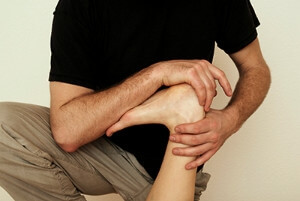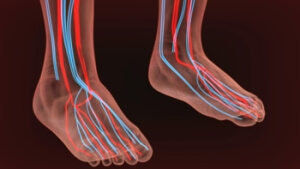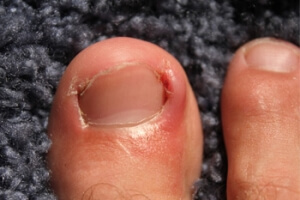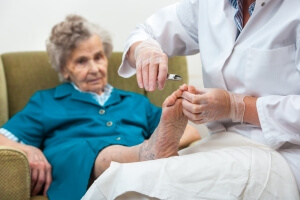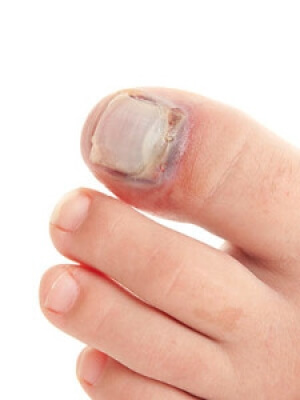Super User
Astros Player Strong After Achilles Tendon Rupture
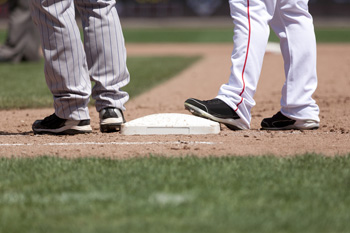 Pitcher Joe Smith of the Houston Astros was facing a long and tough recovery when he ruptured the Achilles tendon in his right ankle last December. Instead of choosing to end his career, however, Smith took on rehabilitation after receiving surgery for the repair. Smith’s decision has proven to be the right one, as the player made his return to the field for the first time this year on July 14th, and he’s been strong and solid since. Smith has played 20 games for the Houston Astros since his return, and in those games, he’s allowed only three earned runs. The pitcher’s proven resilience has made him a key player for the Astros as they move forward. If you believe that you’ve experienced an Achilles tendon injury, consult with your podiatrist.
Pitcher Joe Smith of the Houston Astros was facing a long and tough recovery when he ruptured the Achilles tendon in his right ankle last December. Instead of choosing to end his career, however, Smith took on rehabilitation after receiving surgery for the repair. Smith’s decision has proven to be the right one, as the player made his return to the field for the first time this year on July 14th, and he’s been strong and solid since. Smith has played 20 games for the Houston Astros since his return, and in those games, he’s allowed only three earned runs. The pitcher’s proven resilience has made him a key player for the Astros as they move forward. If you believe that you’ve experienced an Achilles tendon injury, consult with your podiatrist.
Achilles tendon injuries need immediate attention to avoid future complications. If you have any concerns, contact one of our podiatrists of New Tampa Foot & Ankle. Our doctors can provide the care you need to keep you pain-free and on your feet.
What Is the Achilles Tendon?
The Achilles tendon is a tendon that connects the lower leg muscles and calf to the heel of the foot. It is the strongest tendon in the human body and is essential for making movement possible. Because this tendon is such an integral part of the body, any injuries to it can create immense difficulties and should immediately be presented to a doctor.
What Are the Symptoms of an Achilles Tendon Injury?
There are various types of injuries that can affect the Achilles tendon. The two most common injuries are Achilles tendinitis and ruptures of the tendon.
Achilles Tendinitis Symptoms
- Inflammation
- Dull to severe pain
- Increased blood flow to the tendon
- Thickening of the tendon
Rupture Symptoms
- Extreme pain and swelling in the foot
- Total immobility
Treatment and Prevention
Achilles tendon injuries are diagnosed by a thorough physical evaluation, which can include an MRI. Treatment involves rest, physical therapy, and in some cases, surgery. However, various preventative measures can be taken to avoid these injuries, such as:
- Thorough stretching of the tendon before and after exercise
- Strengthening exercises like calf raises, squats, leg curls, leg extensions, leg raises, lunges, and leg presses
If you have any questions please feel free to contact our office located in Wesley Chapel, FL . We offer the newest diagnostic tools and technology to treat your foot and ankle needs.
Why Is It Important To Stretch The Feet?
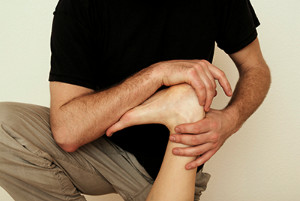 When the feet are strong, the risk of an injury occurring may decrease. This can be accomplished by performing gentle stretching and exercise techniques, and it can generally improve the overall health of the foot as well. Research has indicated that walking is considered to be one of the best forms of exercising the feet. This may be a result of the feet completing a full range of motion as the foot touches the ground, and pushes off for the next step. While performing resistance exercises, weights will generally be used to strengthen the muscles, and this can provide overall stability and support to the feet. Flexibility exercises are accomplished by frequently performing gentle stretches, and this can help in keeping the feet limber. If you would like additional information about the benefits of stretching the feet, it is suggested that you consult with a podiatrist.
When the feet are strong, the risk of an injury occurring may decrease. This can be accomplished by performing gentle stretching and exercise techniques, and it can generally improve the overall health of the foot as well. Research has indicated that walking is considered to be one of the best forms of exercising the feet. This may be a result of the feet completing a full range of motion as the foot touches the ground, and pushes off for the next step. While performing resistance exercises, weights will generally be used to strengthen the muscles, and this can provide overall stability and support to the feet. Flexibility exercises are accomplished by frequently performing gentle stretches, and this can help in keeping the feet limber. If you would like additional information about the benefits of stretching the feet, it is suggested that you consult with a podiatrist.
Stretching the feet is a great way to prevent injuries. If you have any concerns with your feet consult with one of our podiatrists from New Tampa Foot & Ankle. Our doctors will assess your condition and provide you with quality foot and ankle treatment.
Stretching the Feet
Being the backbone of the body, the feet carry your entire weight and can easily become overexerted, causing cramps and pain. As with any body part, stretching your feet can serve many benefits. From increasing flexibility to even providing some pain relief, be sure to give your feet a stretch from time to time. This is especially important for athletes or anyone performing aerobic exercises, but anyone experiencing foot pain or is on their feet constantly should also engage in this practice.
Great ways to stretch your feet:
- Crossing one leg over the others and carefully pull your toes back. Do 10-20 repetitions and repeat the process for each foot
- Face a wall with your arms out and hands flat against the wall. Step back with one foot and keep it flat on the floor while moving the other leg forward. Lean towards the wall until you feel a stretch. Hold for 30 seconds and perform 10 repetitions for each foot
- Be sure not to overextend or push your limbs too hard or you could risk pulling or straining your muscle
Individuals who tend to their feet by regular stretching every day should be able to minimize foot pain and prevent new problems from arising.
If you have any questions, please feel free to contact our office located in Wesley Chapel, FL . We offer the newest diagnostic and treatment technologies for all your foot care needs.
Swollen Feet Are Common During Pregnancy
 Many pregnant women experience swollen and achy feet during their pregnancies. This is a result of the growing fetus, in addition to the body producing excess fluid. There are methods that can be implemented which can help to reduce discomfort in the feet that is often experienced during the latter stages of pregnancy. These include elevating your feet as often as possible throughout the day, limiting your sodium intake, and stretching the calf muscles and toes. Some women find it helpful to wear compression stockings, as these may be beneficial in controlling persistent swelling. If you would like additional information about how pregnancy can affect the feet, please consult with a podiatrist.
Many pregnant women experience swollen and achy feet during their pregnancies. This is a result of the growing fetus, in addition to the body producing excess fluid. There are methods that can be implemented which can help to reduce discomfort in the feet that is often experienced during the latter stages of pregnancy. These include elevating your feet as often as possible throughout the day, limiting your sodium intake, and stretching the calf muscles and toes. Some women find it helpful to wear compression stockings, as these may be beneficial in controlling persistent swelling. If you would like additional information about how pregnancy can affect the feet, please consult with a podiatrist.
Pregnant women with swollen feet can be treated with a variety of different methods that are readily available. For more information about other cures for swollen feet during pregnancy, consult with one of our podiatrists from New Tampa Foot & Ankle. Our doctors will attend to all of your foot and ankle needs.
What Foot Problems Can Arise During Pregnancy?
One problem that can occur is overpronation, which occurs when the arch of the foot flattens and tends to roll inward. This can cause pain and discomfort in your heels while you’re walking or even just standing up, trying to support your baby.
Another problem is edema, or swelling in the extremities. This often affects the feet during pregnancy but tends to occur in the later stages.
How Can I Keep My Feet Healthy During Pregnancy?
- Wearing orthotics can provide extra support for the feet and help distribute weight evenly
- Minimize the amount of time spent walking barefoot
- Wear shoes with good arch support
- Wear shoes that allow for good circulation to the feet
- Elevate feet if you experience swelling
- Massage your feet
- Get regular, light exercise, such as walking, to promote blood circulation to the feet
If you have any questions please feel free to contact our office located in Wesley Chapel, FL . We offer the newest diagnostic and treatment technologies for all your foot and ankle needs.
Foot Injuries in Children During the Summer
 Summer typically brings about a lot more activity in children. The warm weather means they want to spend time outside. Also, many sports start or continue in the summer months, such as basketball, tennis, running and soccer. Adults should be looking out for certain foot injuries in children so they can remain healthy. These injuries include ankle sprains, plantar fasciitis, tendinitis, corns and calluses. There are also a few preventative measures to take. You could tape the ankles to help with stability, and make sure the socks absorb moisture. As for shoes, some sports require specific types of shoes, and new footwear may need to be purchased, as children’s feet grow quickly. Children may not complain of pain, because they have not noticed it or they want to continue being active. Thus, adults should be observant of their children’s feet. If you suspect your child has a foot or ankle injury, it is suggested to consult with a podiatrist.
Summer typically brings about a lot more activity in children. The warm weather means they want to spend time outside. Also, many sports start or continue in the summer months, such as basketball, tennis, running and soccer. Adults should be looking out for certain foot injuries in children so they can remain healthy. These injuries include ankle sprains, plantar fasciitis, tendinitis, corns and calluses. There are also a few preventative measures to take. You could tape the ankles to help with stability, and make sure the socks absorb moisture. As for shoes, some sports require specific types of shoes, and new footwear may need to be purchased, as children’s feet grow quickly. Children may not complain of pain, because they have not noticed it or they want to continue being active. Thus, adults should be observant of their children’s feet. If you suspect your child has a foot or ankle injury, it is suggested to consult with a podiatrist.
Making sure that your children maintain good foot health is very important as they grow. If you have any questions, contact one of our podiatrists of New Tampa Foot & Ankle. Our doctors can provide the care you need to keep you pain-free and on your feet.
Keeping Children's Feet Healthy
Having healthy feet during childhood can help prevent medical problems later in life, namely in the back and legs. As children grow, their feet require different types of care. Here are some things to consider...
Although babies do not walk yet, it is still very important to take care of their feet.
Avoid putting tight shoes or socks on his or her feet.
Allow the baby to stretch and kick his or her feet to feel comfortable.
As a toddler, kids are now on the move and begin to develop differently. At this age, toddlers are getting a feel for walking, so don’t be alarmed if your toddler is unsteady or ‘walks funny’.
As your child gets older, it is important to teach them how to take care of their feet.
Show them proper hygiene to prevent infections such as fungus.
Be watchful for any pain or injury.
Have all injuries checked by a doctor as soon as possible.
Comfortable, protective shoes should always be worn, especially at play.
If you have any questions please feel free to contact our office located in Wesley Chapel, FL . We offer the newest diagnostic and treatment technologies for all your foot and ankle needs.
Peripheral Artery Disease Overview
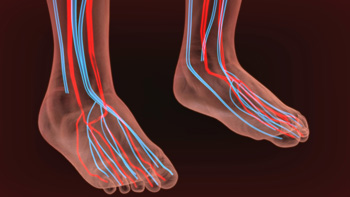 Peripheral artery disease, or PAD, is commonly caused by a buildup of plaque deposited in the walls of blood vessels. This plaque is made of cholesterol and fatty substances that can cause the arteries to become stiff and narrowed. Patients at the highest risk for developing PAD are those with diabetes or those who have a history of smoking. Other risk factors include high cholesterol, kidney disease and high blood pressure. Some symptoms that can occur from PAD are muscle cramps, reduced blood flow, weakness in legs and feet, color changes in the skin and dark purple or black spots that can develop on the toes. There are some ways to combat the symptoms. Standing and resting for a few minutes will cause the symptoms that stopped someone from walking to resolve. Also over time, people with PAD will tend to limit what they do in order to avoid symptoms, walk slower and use a cane. If you are currently experiencing symptoms of peripheral artery disease, it is advised that you schedule an appointment with a podiatrist.
Peripheral artery disease, or PAD, is commonly caused by a buildup of plaque deposited in the walls of blood vessels. This plaque is made of cholesterol and fatty substances that can cause the arteries to become stiff and narrowed. Patients at the highest risk for developing PAD are those with diabetes or those who have a history of smoking. Other risk factors include high cholesterol, kidney disease and high blood pressure. Some symptoms that can occur from PAD are muscle cramps, reduced blood flow, weakness in legs and feet, color changes in the skin and dark purple or black spots that can develop on the toes. There are some ways to combat the symptoms. Standing and resting for a few minutes will cause the symptoms that stopped someone from walking to resolve. Also over time, people with PAD will tend to limit what they do in order to avoid symptoms, walk slower and use a cane. If you are currently experiencing symptoms of peripheral artery disease, it is advised that you schedule an appointment with a podiatrist.
Peripheral artery disease can pose a serious risk to your health. It can increase the risk of stroke and heart attack. If you have symptoms of peripheral artery disease, consult with one of our podiatrists from New Tampa Foot & Ankle. Our doctors will assess your condition and provide you with quality foot and ankle treatment.
Peripheral artery disease (PAD) is when arteries are constricted due to plaque (fatty deposits) build-up. This results in less blood flow to the legs and other extremities. The main cause of PAD is atherosclerosis, in which plaque builds up in the arteries.
Symptoms
Symptoms of PAD include:
- Claudication (leg pain from walking)
- Numbness in legs
- Decrease in growth of leg hair and toenails
- Paleness of the skin
- Erectile dysfunction
- Sores and wounds on legs and feet that won’t heal
- Coldness in one leg
It is important to note that a majority of individuals never show any symptoms of PAD.
Diagnosis
While PAD occurs in the legs and arteries, Podiatrists can diagnose PAD. Podiatrists utilize a test called an ankle-brachial index (ABI). An ABI test compares blood pressure in your arm to you ankle to see if any abnormality occurs. Ultrasound and imaging devices may also be used.
Treatment
Fortunately, lifestyle changes such as maintaining a healthy diet, exercising, managing cholesterol and blood sugar levels, and quitting smoking, can all treat PAD. Medications that prevent clots from occurring can be prescribed. Finally, in some cases, surgery may be recommended.
If you have any questions, please feel free to contact our office located in Wesley Chapel, FL . We offer the newest diagnostic and treatment technologies for all your foot care needs.
How Do Ingrown Toenails Develop?
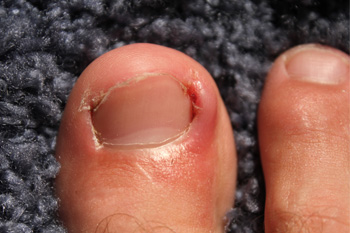 A common symptom of an ingrown toenail appears as red skin on one or both sides of the big toe. It occurs as a result of the nail growing into the skin, and can happen from wearing shoes that do not fit correctly. Additional reasons this ailment may occur can include if the toenails are trimmed too short, or if there has been an injury that happened to the toe. The skin may appear swollen, there may be pus draining from the nail, and it may be painful to walk. Some patients find it beneficial to soak the affected nail in warm water, as this can help to make it easier to lift the nail away from the skin. There are measures that can be implemented which may prevent ingrown toenails. These consist of wearing shoes and socks that fit correctly, and trimming the toenails in a straight line. If you have an ingrown toenail, it is advised that you seek the counsel of a podiatrist who can properly treat this condition, which may help to avoid an infection.
A common symptom of an ingrown toenail appears as red skin on one or both sides of the big toe. It occurs as a result of the nail growing into the skin, and can happen from wearing shoes that do not fit correctly. Additional reasons this ailment may occur can include if the toenails are trimmed too short, or if there has been an injury that happened to the toe. The skin may appear swollen, there may be pus draining from the nail, and it may be painful to walk. Some patients find it beneficial to soak the affected nail in warm water, as this can help to make it easier to lift the nail away from the skin. There are measures that can be implemented which may prevent ingrown toenails. These consist of wearing shoes and socks that fit correctly, and trimming the toenails in a straight line. If you have an ingrown toenail, it is advised that you seek the counsel of a podiatrist who can properly treat this condition, which may help to avoid an infection.
Ingrown toenails may initially present themselves as a minor discomfort, but they may progress into an infection in the skin without proper treatment. For more information about ingrown toenails, contact one of our podiatrists of New Tampa Foot & Ankle. Our doctors can provide the care you need to keep you pain-free and on your feet.
Ingrown Toenails
Ingrown toenails are caused when the corner or side of a toenail grows into the soft flesh surrounding it. They often result in redness, swelling, pain, and in some cases, infection. This condition typically affects the big toe and may recur if it is not treated properly.
Causes
- Improper toenail trimming
- Genetics
- Improper shoe fitting
- Injury from pedicures or nail picking
- Abnormal gait
- Poor hygiene
You are more likely to develop an ingrown toenail if you are obese, have diabetes, arthritis, or have any fungal infection in your nails. Additionally, people who have foot or toe deformities are at a higher risk of developing an ingrown toenail.
Symptoms
Some symptoms of ingrown toenails are redness, swelling, and pain. In rare cases, there may be a yellowish drainage coming from the nail.
Treatment
Ignoring an ingrown toenail can have serious complications. Infections of the nail border can progress to a deeper soft-tissue infection, which can then turn into a bone infection. You should always speak with your podiatrist if you suspect you have an ingrown toenail, especially if you have diabetes or poor circulation.
If you have any questions, please feel free to contact our office located in Wesley Chapel, FL . We offer the newest diagnostic and treatment technologies for all your foot care needs.
Peripheral Neuropathy
Peripheral neuropathy is a result of dam age done to the nerves outside of the brain and spinal cord. This will often cause weakness, numbness, and pain in the feet. This type of neuropathy can result from traumatic injuries, infections, metabolic problems, inherited causes and an exposure to toxins. The symptoms include muscle weakness, a lack of coordination and falling, sharp burning pain, numbness and extreme sensitivity to touch. People who have diabetes, kidney and thyroid disorders, vitamin deficiencies and have a history of alcohol abuse are at an increased risk to acquire peripheral neuropathy. Complications that can arise are infections, burns and skin trauma and an increased propensity to falls. The risk for peripheral neuropathy can be decreased by exercising regularly, avoiding factors that may cause nerve damage and eating a diet that is rich in fruits, vegetables and protein. If you feel that you may be at risk for peripheral neuropathy, it is advised to consult with a podiatrist.
age done to the nerves outside of the brain and spinal cord. This will often cause weakness, numbness, and pain in the feet. This type of neuropathy can result from traumatic injuries, infections, metabolic problems, inherited causes and an exposure to toxins. The symptoms include muscle weakness, a lack of coordination and falling, sharp burning pain, numbness and extreme sensitivity to touch. People who have diabetes, kidney and thyroid disorders, vitamin deficiencies and have a history of alcohol abuse are at an increased risk to acquire peripheral neuropathy. Complications that can arise are infections, burns and skin trauma and an increased propensity to falls. The risk for peripheral neuropathy can be decreased by exercising regularly, avoiding factors that may cause nerve damage and eating a diet that is rich in fruits, vegetables and protein. If you feel that you may be at risk for peripheral neuropathy, it is advised to consult with a podiatrist.
Neuropathy
Neuropathy can be a potentially serious condition, especially if it is left undiagnosed. If you have any concerns that you may be experiencing nerve loss in your feet, consult with one of our podiatrists from New Tampa Foot & Ankle. Our doctors will assess your condition and provide you with quality foot and ankle treatment for neuropathy.
What Is Neuropathy?
Neuropathy is a condition that leads to damage to the nerves in the body. Peripheral neuropathy, or neuropathy that affects your peripheral nervous system, usually occurs in the feet. Neuropathy can be triggered by a number of different causes. Such causes include diabetes, infections, cancers, disorders, and toxic substances.
Symptoms of Neuropathy Include:
- Numbness
- Sensation loss
- Prickling and tingling sensations
- Throbbing, freezing, burning pains
- Muscle weakness
Those with diabetes are at serious risk due to being unable to feel an ulcer on their feet. Diabetics usually also suffer from poor blood circulation. This can lead to the wound not healing, infections occurring, and the limb may have to be amputated.
Treatment
To treat neuropathy in the foot, podiatrists will first diagnose the cause of the neuropathy. Figuring out the underlying cause of the neuropathy will allow the podiatrist to prescribe the best treatment, whether it be caused by diabetes, toxic substance exposure, infection, etc. If the nerve has not died, then it’s possible that sensation may be able to return to the foot.
Pain medication may be issued for pain. Electrical nerve stimulation can be used to stimulate nerves. If the neuropathy is caused from pressure on the nerves, then surgery may be necessary.
If you have any questions, please feel free to contact our office located in Wesley Chapel, FL . We offer the newest diagnostic and treatment technologies for all your foot care needs.
Proper Foot Care May Help to Prevent Painful Foot Conditions
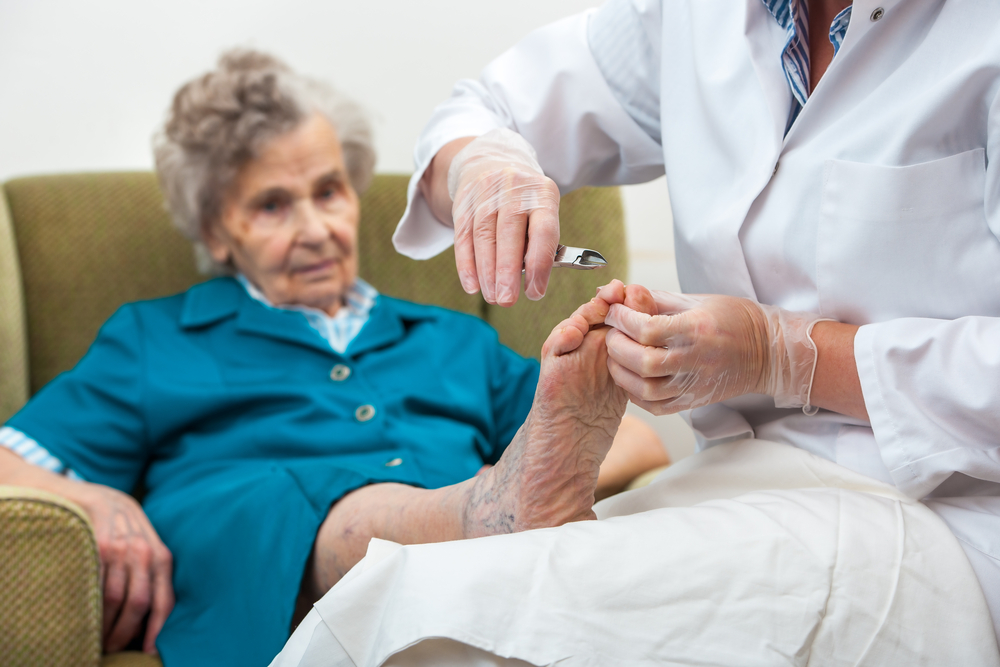 Many elderly people know the importance of maintaining proper foot care. The feet need to be healthy so immobility does not become a concern. When the toenails are trimmed correctly, ingrown toenails can be prevented. As the aging process occurs, it can become difficult to wash, dry, and trim the toenails. It may be easier if a caregiver can help to accomplish these tasks, in addition to noticing any sores or changes in skin color. It is beneficial to use a moisturizing lotion on the feet daily, as this is often helpful in preventing cracked heels. The feet will feel better when the correct size shoes are worn, and painful foot conditions that include bunions and hammertoes are prevented. If you would like additional information about care for elderly feet, it is suggested that you consult with a podiatrist.
Many elderly people know the importance of maintaining proper foot care. The feet need to be healthy so immobility does not become a concern. When the toenails are trimmed correctly, ingrown toenails can be prevented. As the aging process occurs, it can become difficult to wash, dry, and trim the toenails. It may be easier if a caregiver can help to accomplish these tasks, in addition to noticing any sores or changes in skin color. It is beneficial to use a moisturizing lotion on the feet daily, as this is often helpful in preventing cracked heels. The feet will feel better when the correct size shoes are worn, and painful foot conditions that include bunions and hammertoes are prevented. If you would like additional information about care for elderly feet, it is suggested that you consult with a podiatrist.
Proper foot care is something many older adults forget to consider. If you have any concerns about your feet and ankles, contact one of our podiatrists from New Tampa Foot & Ankle. Our doctors can provide the care you need to keep you pain-free and on your feet.
The Elderly and Their Feet
As we age we start to notice many changes in our body, but the elder population may not notice them right away. Medical conditions may prevent the elderly to take notice of their foot health right away. Poor vision is a lead contributor to not taking action for the elderly.
Common Conditions
- Neuropathy – can reduce feeling in the feet and can hide many life-threatening medical conditions.
- Reduced flexibility – prevents the ability of proper toenail trimming, and foot cleaning. If left untreated, it may lead to further medical issues.
- Foot sores – amongst the older population can be serious before they are discovered. Some of the problematic conditions they may face are:
- Gouging toenails affecting nearby toe
- Shoes that don’t fit properly
- Pressure sores
- Loss of circulation in legs & feet
- Edema & swelling of feet and ankles
Susceptible Infections
Diabetes and poor circulation can cause general loss of sensitivity over the years, turning a simple cut into a serious issue.
If you have any questions please feel free to contact our office located in Wesley Chapel, FL . We offer the newest diagnostic and treatment technologies for all your foot and ankle needs.
Elderly Foot Care
As you grow older, you will start to notice more problems with your feet due to wear and tear. This may also happen because the skin will start to become thin and lose elasticity. Some signs of aging feet are regular aches and pains, bunion development, and clawed toes.
Fortunately, there are ways you can improve comfort, relieve pain, and maintain mobility in your feet. One of the best ways to deal with aging feet is to exercise. If you keep active, your muscles will become toned which will then strengthen the arches in the foot and stimulate blood circulation.
It is important that you practice proper foot care to protect your aging feet. You should wash your feet in warm water on an everyday basis. Afterward, the feet need to be dried well and it is important to dry between the toes. Your toenails should be trimmed and kept under control; nails that are poorly cut may become ingrown. At the end of each day, performing an inspection of your feet will allow you to detect any ailments in their early stages.
As you grow older, it becomes more important that you wear comfortable shoes. Your shoes should be secure, and they should provide decent arch support. If you are looking to buy a new pair of shoes, it is best to look for a pair that are made from a breathable material. It is also helpful to have shoes that have a bit of extra room at the top of the shoe, especially if you suffer from swollen feet.
The most common foot problems that elderly people will encounter are bunions, calluses, corns, hammertoes, heel pain, and foot problems related to diabetes. Some other issues include arch pain, tarsal tunnel syndrome, Achilles tendonitis, and Morton’s neuroma
An annual foot examination is a great way for you to ensure that you do not have any serious health problems with your feet. You should talk to a podiatrist about the available treatment options for whichever foot issue you are dealing with.
How Do Toes Become Fractured?
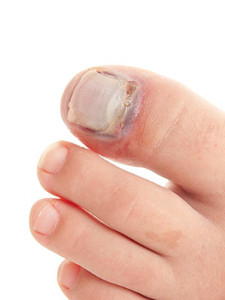 There are several ways to fracture a toe. These can include dropping a heavy object on it, unexpectedly stepping off of a curb, or hitting it against a piece of furniture. The symptoms that are associated with broken toes often include severe pain and discomfort, swelling, and bruising. Many patients hear a popping sound as the toe fractures, and it may appear deformed. It is generally difficult to wear shoes with a broken toe, and walking may be challenging. Mild relief may be found when the toe is elevated, as this is often helpful in reducing any existing swelling. It may be beneficial for the affected toe to be taped to the toe next to it, so it can have the necessary stability as the healing process occurs. If you have fractured your toe, it is suggested to consult with a podiatrist who can properly treat this condition.
There are several ways to fracture a toe. These can include dropping a heavy object on it, unexpectedly stepping off of a curb, or hitting it against a piece of furniture. The symptoms that are associated with broken toes often include severe pain and discomfort, swelling, and bruising. Many patients hear a popping sound as the toe fractures, and it may appear deformed. It is generally difficult to wear shoes with a broken toe, and walking may be challenging. Mild relief may be found when the toe is elevated, as this is often helpful in reducing any existing swelling. It may be beneficial for the affected toe to be taped to the toe next to it, so it can have the necessary stability as the healing process occurs. If you have fractured your toe, it is suggested to consult with a podiatrist who can properly treat this condition.
A broken toe can be very painful and lead to complications if not properly fixed. If you have any concerns about your feet, contact one of our podiatrists from New Tampa Foot & Ankle. Our doctors will treat your foot and ankle needs.
What to Know About a Broken Toe
Although most people try to avoid foot trauma such as banging, stubbing, or dropping heavy objects on their feet, the unfortunate fact is that it is a common occurrence. Given the fact that toes are positioned in front of the feet, they typically sustain the brunt of such trauma. When trauma occurs to a toe, the result can be a painful break (fracture).
Symptoms of a Broken Toe
- Throbbing pain
- Swelling
- Bruising on the skin and toenail
- The inability to move the toe
- Toe appears crooked or disfigured
- Tingling or numbness in the toe
Generally, it is best to stay off of the injured toe with the affected foot elevated.
Severe toe fractures may be treated with a splint, cast, and in some cases, minor surgery. Due to its position and the pressure it endures with daily activity, future complications can occur if the big toe is not properly treated.
If you have any questions please feel free to contact our office located in Wesley Chapel, FL . We offer the newest diagnostic and treatment technologies for all your foot and ankle needs.

